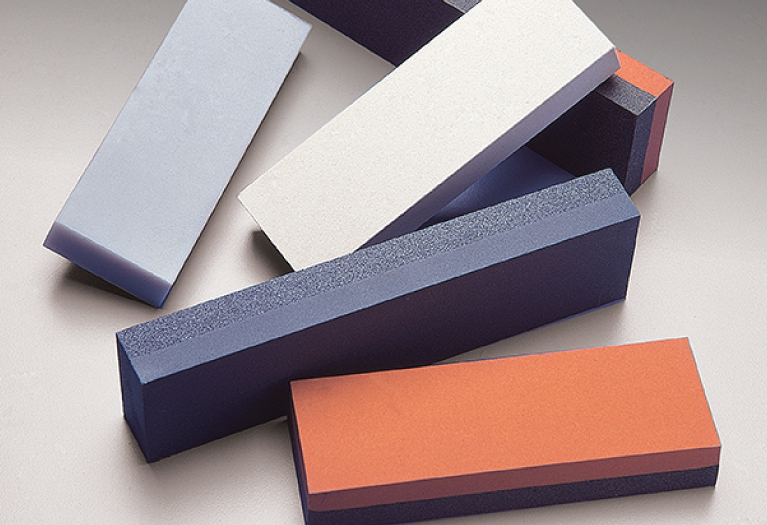 |
Are you finding that your knives, scissors, or other cutting tools are dull and need to be sharpened but aren’t sure which sharpening stone to choose?Explore the three most common types of sharpening stones: benchstones, waterstones, and diamond stones, and learn about the different finishes each type of stone imparts. |
Benchstones |
| Benchstones are the most commonly used sharpening stones and are also known as oilstones or whetstones. As the term oilstone suggests, a thin layer of oil is typically used as a lubricant on this type of stone to enhance sharpening performance and to keep the sharpening surface from loading or glazing.
Man-made benchstones come in a variety of sizes and shapes and are available in a range of grit sizes: coarse (80-100 grit), medium (150-220 grit), and fine (280-320 grit). Benchstones are durable, wear slowly, and retain their flatness significantly longer than waterstones.
Man-made benchstones are primarily available in two different types of abrasive: aluminum oxide (India stones) and silicon carbide (Crystolon stones). |  Norton Benchstones |
| India Stones
Crystolon Stones
Because sharpening is frequently a progression, first repairing an edge with a coarse grit stone and then perfecting the edge with a fine grit stone, many people choose to buy a combination stone, which utilizes a coarse grit on one side and a fine grit on the other side. It is also common practice to use a Crystolon stone for initial coarse grit sharpening before moving on to an India stone and then finishing with an Arkansas stone, a natural benchstone. |
 Norton Arkansas Benchstones | Arkansas Stones
|
Learn how to get the most out of your benchstones with our answers to the most frequently asked questions in our guide to benchstones. |
Waterstones |
| Waterstones are synthetic stones that have become increasingly popular. They are designed to be much softer and more porous than traditional benchstones, with abrasive grit from the stone forming a fast-cutting slurry on the surface of the stone during the sharpening process. |
 Norton Waterstones | Waterstones should be completely soaked in water for several minutes prior to use, ensuring that the water has penetrated through the entire stone. Waterstones are typically made from aluminum oxide or silicon carbide, depending on the grit size, but the abrasive/bond combination makes these stones cut faster than benchstones and impart a much smoother finish.
Waterstones are available in a range of grit sizes, like man-made benchstones, but are usually available in much finer grits than benchstones. Waterstone grits are typically measured based on the Japanese system and are not directly comparable to grit sizes used for benchstones and diamond stones. For example, a 1000 grit waterstone is close in surface finish to a 320 grit benchstone. Additional comparisons can be found in the table below.
|
| CRYSTOLON | ARKANSAS | WATERSTONES | DIAMOND STONES |
| Coarse Crystolon | |||
| Coarse India | |||
| Medium Crystolon | |||
| Norton 220 | Extra Coarse Diamond (220) | ||
| Medium India | |||
| Fine Crystolon | |||
| Coarse Diamond (325) | |||
| 360 | |||
| Fine India | |||
| Soft Arkansas | 600 | Fine Diamond (600) | |
| 800 | |||
| Norton 1000 | |||
| 1200 | |||
| 1500 | |||
| Hard Translucent Arkansas | Norton 4000 | ||
| Norton 8000 | |||
| 15000 |
Table 1. Relative Sharpening Comparisons for the Sharpening Stones Discussed in This Article
| Because Waterstones are softer than benchstones, they wear much more quickly and need to be flattened frequently for optimal performance.
For tips and recommendations for using and caring for your waterstones, check out our guide to waterstones FAQ article. |
Diamond Stones |
| Diamond stones are the fastest and most aggressive sharpening stones. They are produced by bonding microscopic diamond crystals to flat perforated or solid steel plates. Diamond stones are long lasting, fast sharpening, and will retain their flatness longer than waterstones and benchstones. They can be used dry or with water or oil as a lubricant.
Because the diamonds are hard and aggressive, diamond stones remove slightly more material than similar grit benchstones and waterstones. In addition, they generally impart a less polished surface than other sharpening stones. Some sharpeners choose to use hard Arkansas or fine grit waterstones as a polishing step after sharpening with diamond stones. |
What Size Sharpening Stone Should I Buy? |
| Once you choose the type of sharpening stone you want to use, how do you determine which size to select? In general, sharpening is more effective when you match the size of your stone to the size of the blade you are sharpening. Small pocket knives can be sharpened on 3” stones and large kitchen knives are best sharpened on 11-1/2” stones.
For the best results, choose a size that allows you to sweep the entire length of the blade across the stone in every sharpening motion.
|  |
Which Sharpening Stone is Right for You? |
| There are many different sharpening stones, but once you’re familiar with the most common types, you’ll be able to choose the right stone for your project.
For a quick overview and comparison of the finishes produced by the benchstones, waterstones, and diamond stones discussed in this article, see our summary below.
To find the right sharpening stone for you, browse our selection of sharpening stones, and for tips and recommendations on using your stones, watch our sharpening stone videos. |